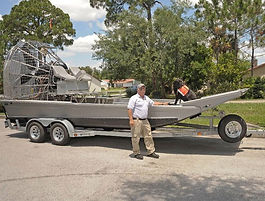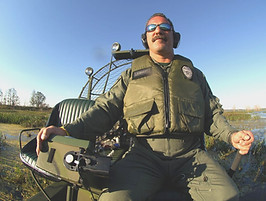
ABOUT US
_JPG.jpg)
Brian Edwards
Brian Edwards is a 40 year veteran of the rescue industry and is Owner/Instructor ofAirboat Training Service of North America, LLC. ATS is a specialized company that conducts advanced Airboat Operations Training in Search/Rescue, Swiftwater Rescue, Ice Rescue and Flood Rescue to Government Agencies, Industry and Fire/Rescue departments throughout the world. He has conducted Airboat Operations Training in Basra Iraq, Tanzania Africa, Bangkok Thailand, Ontario Canada and Alaska along with covering most of the States East of the Mississippi. A listing of his clients include the United States Coast Guard, British Military, Iraqi Coast Guard, Thailand Royal Guard, Alyeska Pipeline, Department of Interior, Indiana Fish andWildlife and Mara River Safari Tours (Tanzania) along with numerous Fire and Rescue teams throughout the Country. He is also the Supervisor & Divemaster for Ballville FireDept.& Sandusky County Water Rescue Team along with being an active Firefighter and past President for Ballville Volunteer Fire Department, Inc., Fremont, Ohio

Kevin Roderiques
Kevin is a 6 year veteran US Coast Guard and has conducted search and rescue missions, as well as drug interdictions. Kevins Airboat experience is extensive. He was Team Commander and Training Coordinator of FL-3 Airboat Search & Rescue Inc., Airboat Training Service of North America (ATSONA) Rescue Airboat Operator, Airboat Training Service of North America (ATSONA) Ice and Swiftwater
Operator, Department Of Interior MOCC Instructor, Department Of Interior Airboat Instructor, and US Coast Guard / Licensed Captain.
Kevin's law enforcement history is valuable in working with multiple agencies in a disaster situation. He was the Beverly Police Department, Harbor master / Marine Patrol- Shell Fish Warden, Essex County Sheriffs Department /Rescue Diver-Marine Patrol. Tampa UT Police Department, and the Tampa International Airport Police Department

George Lainhart
Bio coming!
OUR HISTORY
Since airboats have been in existence, various airboating individuals and members of the airboating community have offered their services to Agency Having Jurisdiction (AHJ) during periods of natural disasters. This assistance was not always welcomed, and even when it was, the airboaters were not always perceived as knowledgeable about airboat rescue operations. This perception was sometimes perpetuated because of a lack of standardized airboat rescue training and the necessary rescue airboat designed and built for all rescue operations.
In 2002, a few firefighters and law enforcement individuals started to compare notes on how they operate airboats in a rescue environment and over the course of a few years, got a rough operational plan together on procedural airboat rescue operations. In 2005 and hours after Hurricane Katrina made landfall, this group of firefighters and law enforcement personnel, along with dozens of other professional airboaters converged on New Orleans to help perform rescue and evacuation operations. The airboats conducted water rescues where no other vessel could safely venture due to debris in the water and constant puncture hazards from within the water. Despite the successes of the trained personnel, there were issues with other untrained airboaters who had little to no training operating airboats in a rescue environment. Unfortunately, this caused some challenges with rescue agencies and US Airboat rescue teams in the same area. Hundreds of other types of water craft were also present all over New Orleans, but there were very few, if any, that didn’t sustain major damage that rendered them “non-operational” very early in the rescue process. Only the airboats were able to traverse anywhere without incident and perform rescues with minimal damage sustained, and still maintain100% operational availability.

The primary airboat team, who are now key members of US Airboat Search and Rescue (USASAR), are firefighters, law enforcement and trained personnel, who made over 4,100 rescues utilizing just ten airboats over a 2.5-day period after Hurricane Katrina. This team was on station for 6 days under the Louisiana Fish and Wildlife Commission and was responsible for the rescues evacuating the three major hospitals.
Soon after, the official USASAR team was created so that Public Safety Agencies can now have access to. Since 2005, the team has worked tirelessly to create a training, operational and personnel configuration that combines the best airboat rescue instructors in the country along with the finest designed and built airboats that can operate in any environment. They have succeeded and many airboat rescues have been successfully conducted because of that commitment to excellence.
The USASAR Team is comprised of airboat rescue personnel from Fire and Law Enforcement services and utilize specially designed and built Search and Rescue (SAR) airboats. These SAR Airboats allow the rescuers to quickly traverse areas where no other watercraft can safely go, and conduct multiple rescues while personnel and victims stay safely out of the flood waters. The SAR Airboats can safely and quickly travel 10 to 20 miles across water, mud, debris, ice, etc, with no damage to the vessel. They can also traverse swiftwater, regardless of current speed or debris content and conduct rescue operations day or night and in wind speeds of up to 45 MPH and 3 feet waves.
Pre-deployement of the USASAR Team is ideal possible. It's been shown that with pre-deployment, the USASAR Team can interact with the local AHJ and local rescuers before the incident escalates to the point of overwhelming all local resources. When the local rescuers are directly involved with the deployed rescue teams, the safety of ALL the rescue personnel is increased, and the overall timeframe of the rescue incident is decreased.
With the correct airboat rescue vessels and training, rescue airboats can conduct mass rescues and evacuations in a matter of hours. The same rescues conducted with regular rescue watercrafts (i.e. inflatable rafts and Jon-boats) could easily take days and tax the local rescue agencies to their limit, or beyond.
The Instructors for USASAR each have over 20 years of rescue airboat experience and have conducted thousands of airboat rescues (over 4,100 in New Orleans alone after Hurricane Katrina). This multi-victim, mass evacuation experience, along with years of swiftwater and ice rescue experience ensures that only the highest trained operators will operate the USASAR Airboats. Their history and skills have proven they are capable of operating safely in all weather conditions and water states (i.e. swiftwater current, flood, ice, hurricane) day or night.